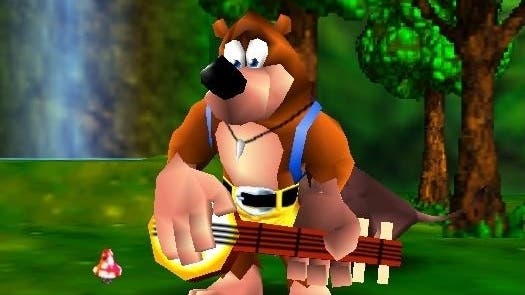Unearthed Nintendo missive reveals why Banjo-Kazooie's infamous Stop 'N' Swop feature was ditched
Including "overheating and...consumer safety".
Nintendo fans of a certain age might recall the excitement surrounding an innovative feature planned for Banjo-Kazooie on N64 which would enable it to interact with its sequel, Banjo-Tooie, opening up previously inaccessible areas and items. Regrettably, the feature was quietly scrapped, but newly unearthed correspondence from Nintendo has finally confirmed why.
First, though, a bit of history; when Banjo-Kazooie released in 1998, players managing to 100% the game were treated to a special secret ending showing Banjo accessing three previously sealed-off areas - a mysterious risen island in Treasure Trove Cove, a frozen ice cave in Freezeezy Peak, and a sealed cliffside doorway in Gobi's Valley. However, despite these tantalising teases, all three areas remained stubbornly inaccessible and it wasn't until a few months after launch that developer Rare offered an explanation.
"All the secret stuff can only be reached when playing Banjo-Tooie, the planned (and naturally better) sequel to Banjo-Kazooie," it wrote on its website, as documented by RareGamer. "Whilst playing 'Tooie, you'll be able to come back to 'Kazooie and grab the hidden goodies, before spiriting them away into the sequel where they will be put to good use."
Rare never officially announced how this mechanism would work in practical terms, but an uncovered patent filing shed a little more light on the matter, explaining players would need to remove a supported game cartridge when prompted, then swap it for a second one, which would read and react to information retained in the console's memory.
The trouble was, when Banjo-Tooie eventually arrived in 2000, the promised inter-game connectivity (known as Stop 'N' Swop) was nowhere to be found. Nor did it turn up in Donkey Kong 64, Conker, Jet Force Gemini, and Perfect Dark, as Rare had initially planned.
Over the years, members of the original development team have hinted Stop 'N' Swop was eventually dropped at the request of Nintendo, but an email now shared by Rare software developer Paul Machacek (as acquired by RareGamer) has laid out the specific reasons for the company's nervousness in relation to the feature, this time straight from the source.
As per the email, Nintendo's director of technical support contacted Rare to request the removal of Stop 'N' Swop during development of Donkey Kong 64 - which was created alongside Banjo, with similar interconnectivity planned - due to uncertainty the N64's memory would retain data long enough to ensure the feature consistently worked as advertised. More seriously, it had concerns about risk of damage to consoles and game cartridges if a swap was made while the power was on, including "overheating and...consumer safety".
"We would like to suggest that you find alternate method of achieving the bonuses in both Banjo and Donkey Kong," the unnamed Nintendo representative wrote, "Perhaps it would be possible to reveal passcode in DK64 which could be used to open the locked area in Banjo?...The balance of DK64, including the different ending could then remain, accessible only to those who played through the new area in Banjo. I believe a solution such as this will preserve some of the benefit of tying the two games together and have minimal impact to the code." And with that, Stop 'N' Swop was effectively no more.
Thankfully, despite the feature's eventual demise, Banjo-Kazooie's Stop 'N' Swop secrets haven't been entirely lost to time and Nintendo's whims, with enterprising players having successfully found ways to access them using cheats buried away in the game's code. And while it's a shame the official means of exploring them never materialised, it's gratifying to know that, some 20 years later, we finally have a definitive answer why.


